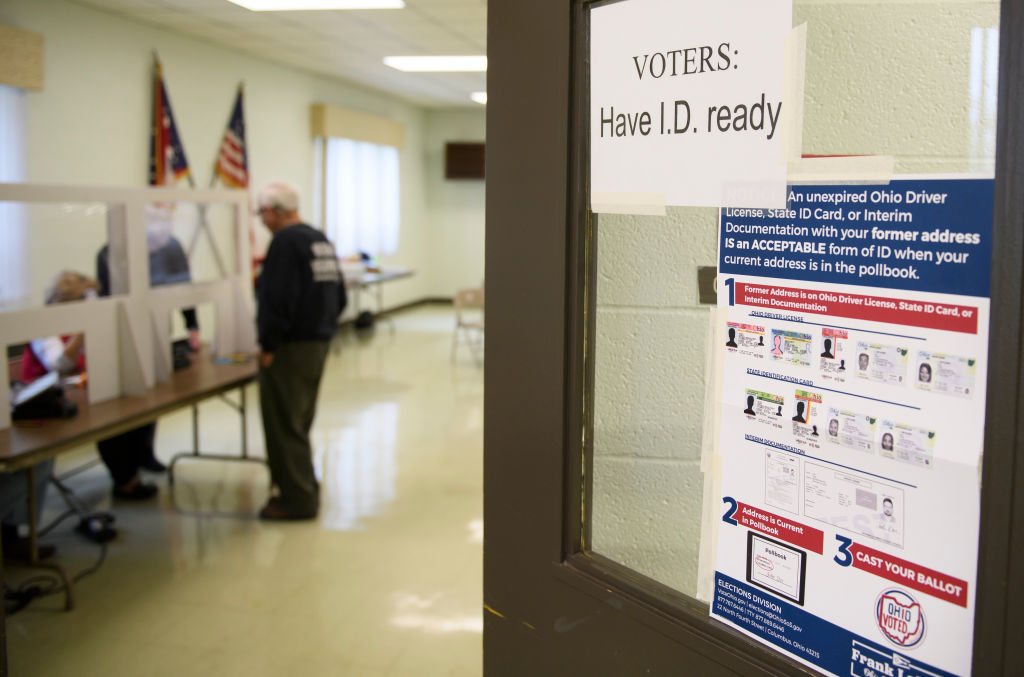
A voter shows identification to an election judge during primary voting in Lordstown, Ohio. (Photo by Jeff Swensen/Getty Images)
Ohio voters are expressing confusion over ballot language written by opponents of Ohio Issue 1, so to be clear: A “Yes” vote establishes a new citizens redistricting commission. A “No” vote keeps politicians on the current Ohio Redistricting Commission in charge.
‘Yes’ vote
If Issue 1 passes, a 15-member citizens redistricting commission will be created to redraw the maps for Ohio Statehouse seats and U.S. Congressional districts beginning with the 2026 election.
The commission would be made up of five Republicans, five Democrats, and five independents.
The citizens on the commission would be chosen by a bipartisan panel of retired judges, who would vet the commission candidates for conflicts of interest, throwing out those who currently holdsor previously held political office, been appointed to a federal, state or local office, or served as a political lobbyist.
“Like a jury, such a commission lacks conflict of interest and is tasked to render an unbiased outcome,” Sam Wang, of the Princeton, NJ-based Electoral Innovation Lab, stated of the citizens redistricting process proposed in Issue 1.
After a map has been adopted by the commission, any court challenges would go to the Ohio Supreme Court, who would review and approve or reject the maps.
The amendment proposal has pledged transparency throughout the process, with public hearings and map-drawing happening in the open for public review and scrutiny.
Under the proposal, the amendment would counter gerrymandering by requiring proportionality as part of the map-drawing process, meaning the commission would have to create districts that matched Ohio voter preferences from recent elections.
Even those who support the amendment have said that would mean the state would still lean more Republican than Democratic, but the margins would not be as large as in maps created under the current process, led by the all-elected-official Ohio Redistricting Commission. Supporters of the measure say the new redistricting model would allow for more competitive districts, leading to more responsive elected officials, more representation and more voter engagement.
No vote
Voting “no” on Issue 1 would mean the process as it stands now would continue. As it currently stands, the Ohio Redistricting Commission holds the power when it comes to Ohio Statehouse maps, and they are the authority on Ohio’s U.S. Congressional map if the state legislature can’t come to an agreement.
The ORC is made up of the state governor, secretary of state and auditor, along with four lawmakers: one individual each appointed by the Senate President, the Speaker of the House, the Senate Minority Leader and the House Minority Leader. The makeup of the commission that created the last six Statehouse maps and two congressional maps starting in 2021 included five Republicans and two Democrats.
The Ohio Supreme Court also reviewed the maps for the Ohio Redistricting Commission when they were challenged, and rejected five of the six Statehouse maps as unduly partisan and unconstitutional. Both congressional maps were also rejected as favoring the Republican Party in a way that did not reflect Ohio voting trends.
The current system requires three public hearings for proposed maps, but does not require map-drawing to take place in public. In one instance, the Ohio Supreme Court suggested the hiring of two independent mapmakers after rejecting a third attempt at Statehouse maps, and a live-feed of the mapmakers was established.
After six days, with mapmakers making $450 per hour, their map was ultimately not taken up by the Ohio Redistricting Commission, and a slightly revised version of a map previously rejected by the state supreme court was approved along party lines.
Those who were on the ORC, specifically Gov. Mike DeWine and Auditor of State Keith Faber, have acknowledged that the current method needs some changes, and that the maps that came out of the ORC could have been improved.
Faber told a gathering of the Columbus Metropolitan Club in October that the current system “doesn’t work very well, it was designed not to work very well, it was designed to compromise.”
However, DeWine, Faber and others, including Senate President Matt Huffman, say the proposed amendment is not the solution, mainly because the parameters set for drawing maps would not improve any redistricting efforts, according to the ORC members. DeWine and Faber have argued proportionality and competitiveness can’t happen in tandem, and the parameters would “force” an outcome, rather than create fair maps.
DeWine has gone so far as to say that whether or not Issue 1 passes, he plans to push the legislature in their next session to introduce the redistricting method used in Iowa.
“What I’m not going to say is ‘never, never, never’ will I ever do that, I’m not going to say it,” DeWine said in July when asked if he would still push for the Iowa plan if Issue 1 passed. “What I hope happens is that we can defeat this in the fall … and I will push and I will do whatever I can to lead so that we end up with something that’s better than what we have now.”
DeWine said he wants put the measure to voters in a future election.
Ohio’s polls will remain open on Tuesday until 7:30 p.m.
YOU MAKE OUR WORK POSSIBLE.

